Serving as a Teton County Search and Rescue volunteer could be mistaken for a full-time job.
“I think when people first come on the team, they get overwhelmed, like, ‘Wow, you have training every month, like a couple of times a month?’” said Carol Viau, 51, a ski instructor and backcountry guide. “There’s a lot going on. Basically, you’re on call 24/7.”
Viau is one of TCSAR’s longest-serving members, with this year marking her 21st season. She’s also part of the team’s smaller short haul crew. They’re the people who fly hanging beneath a helicopter when steep or otherwise difficult terrain makes it impossible to land.
“Basically, what happens is you rig the helicopter so that you have this band underneath the helicopter and a rope attached to that, and then the short hauler hooks onto that rope and the helicopter as they fly,” Viau said, asked to explain how a short haul rescue works. “Usually, we’ll insert people and then someone will fly away with the patient.”
That’s what was needed on Friday, Jan. 15, when a woman about Viau’s age injured her knee while skiing Edelweiss on the south side of Teton Pass. Viau was free for the rescue, along with her teammate Jen Reddy, a 43-year-old illustrator and graphic designer. The pairing made them the first all-female short haul crew in TCSAR’s history—with the exception of a solo short haul rescue Viau conducted in Grand Teton National Park in 2019, she said.

A screenshot from a video filmed by TCSAR volunteer Jenn Sparks shows Viau and Reddy lifting off with the injured skier on Friday, Jan. 15. (Courtesy of Jenn Sparks)
“I don’t think that it was a conscious like, ‘Yeah, let’s bring the ladies out!’” Reddy said. “It was more of who was available and who was ready to go in the field.”
Still, Viau and Reddy’s rescue was rare enough on a team of 29 men and seven women that fellow TCSAR volunteer Mike Moyer made sure to capture the moment on video. “Making history here!” he says, shortly after starting to record.
Both Viau and Reddy were able to fly out with the patient after securing her in a so-called “screamer suit,” which is unusual for a short haul. Weight limits normally force one short hauler to leave the rescue site under their own power, whether on foot or by skis.
“We were both inserted and then we realized, ‘Oh, wait, we don’t weigh as much as like two guys,” Viau said. “So, he [the pilot] could fly us all back out.”
“It was great to have Carol on there because between the two of us communicating with the ship and the patient, it definitely reassured the patient,” Reddy added. “She was a little nervous, had her eyes like absolutely crunched shut. And we were like, ‘It’s okay to look, it’s actually really beautiful!’ And she kind of relaxed when she did open her eyes and look around.”
Besides the physical differences that women often weigh less than men and can sometimes fit into smaller spaces during rescues—caves for example—both Viau and Reddy said women bring other important skills to the team that are critical to successful backcountry rescues.
“I guess we add a different perspective, and there’s a lot of good leadership that can come from that,” Viau said. “There’s advantages and disadvantages as far as sizes and genders, but I think a good mix just makes for a better overall team.”
“Women, without falling into a gender bias, tend to have a little bit more of the soft skills that are needed on rescues as well, to be able to comfort and to just connect with the patients,” Reddy said. And not just patients, but bystanders too—the friends and loved ones who may be even more traumatized from witnessing an injury than the person who sustains it.
Both women also said some skills needed for search and rescue can be taught. No one needs to check every box in order to apply.
“Women have amazing skills in the backcountry, and you just look around, especially in a community like Jackson, there are so many strong female athletes who are incredibly skilled in their chosen area of recreation,” Reddy said. “I think we can bring that to search and rescue. And I’d love to see more women represented.”
Reddy joined TCSAR during the last round of recruitment in 2015. The team waits about three to five years before bringing on a new class of volunteers, and that process will open up again this spring. Of course, men can apply too.
“There’s certainly times where we need some to do some heavy lifting, and it’s great to have some big guys on the team” Viau said. “I like to think I’m pretty burly, but I can only lift so much.”
A second video from the January rescue filmed from the ground by Jenn Sparks, another TCSAR volunteer, shows Viau and Reddy lifting off with the injured skier. The short haulers are clad in bright yellow jackets and white TCSAR helmets, which diminish from view as the trio ascends up over towering pines.
Asked what it’s like to fly through the Tetons hanging from a helicopter, Reddy said she was anxious the first time—and worried that she might be motion sickness. “I didn’t really know what to expect, but it’s actually really peaceful. It doesn’t feel as terrifying as you would think,” she said. “I don’t paraglide, but I imagine it’s very similar to that. It’s like you’re on a swing and you’re traveling through the sky.”
After more than 20 years, Viau said short hauling is kind of like driving down the road for her at this point. But one thing remains the same as when she joined the team: enjoying a hot chocolate at the end of every rescue.






